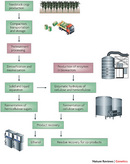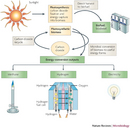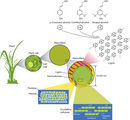« Prev Next »
Not a week goes by without some report on an innovative improvement in biofuel production or efficiency of some sort. The growing enthusiasm of bio-based energy sources is motivated by the pending energy crisis, due to the depletion of the world's oil reserves — a concept known as "peak oil" (Goldemberg 2007). There is indeed global scientific consensus that the use of fossil fuels is causing dramatic changes in the climate of our planet, and it is this scientific discussion that motivates research into optimizing new sustainable sources from biological material (Stern 2006, Vertés et al. 2006, Escobar et al. 2009).
Early Thinking on Biofuels
The concept of biofuels is hardly new to humankind. Using biological material for energy production dates far back in human history but only in the last few decades have we begun to exploit them as a large scale alternative (El Bassam 1998). Of course, as a trivial example, there is the fact that firewood warmed houses and cooked food for millennia, but — better suited as a technological example — even the first diesel engine (around 1900) has been tested to see if it could work on a non-mineral alternative. Its creator, the engineer Rudolf Diesel (1912, 1913), once wrote: "The [diesel] engine was constructed for using mineral oil, and was then worked on vegetable oil without any alterations being made." He goes on to provide quantitative data: "Consumption of earth-nut oil, 240 grammes (0.53 lb.) per brake horse-power-hour; calorific power of the oil, 8600 calories (34,124 B.Th.U.) per kg., thus fully equal to tar oils; hydrogen 11.8 per cent. This oil is almost as effective as the natural mineral oils. . . . Thus this engine becomes a really independent engine for the tropics." The engineer even makes in conclusion a rather prophetic statement: "In any case, they make it certain that motor-power can still be produced from the heat of the sun, which is always available for agricultural purposes, even when all our natural stores of solid and liquid fuels are exhausted."
Nevertheless, humankind has not been able to focus on plant resources for powering engines over the intervening century since Diesel's words. One important reason for this is the fact that fossil fuels are still cheap and readily available, while the available alternatives, struggling to get the processing and the logistics in order, cost more. What follows is a consideration of plant sources, and a discussion of their energy efficiency. Which plants are available for biofuel production? What types of biofuels can we derive from them? And what are the advantages and disadvantages of each?
Vegetable Oils: The First Generation Biofuels
The first attempts to produce a biologically-based fuel to replace mineral petrol and diesel, continued to look for derivatives of well-known agricultural products. There is a variety of vegetable oils, traditionally used in the kitchen, such as palm, sunflower or rapeseed oil. These oils, chemically consisting of triglycerides, are being transesterified into diesel, using an alcohol (such as methanol) as coreactant and an acid or a base as catalyst (Naik et al. 2010).
Additionally, there are several agricultural products that are rich in carbohydrates due to a high starch content, such as corn, wheat, potato and cassava, or due to a high sugar content, such as sugar beet, sugar cane, fruit or palm juice (Naik et al. 2010). These types of biomass can be converted into ethanol via fermentation (of the sugars) or after hydrolysis of the starch into fermentable sugars (Walter & Ensinas 2010). Of course these are not the only plants that can be converted into fuel, but they are the most widely used and analyzed thus far (Figure 1).
The Downsides of Biofuels
There is clearly a long way to go. This production comes at the expense of large amounts of public funding. Laura Ruth (2008) reports: "US producers receive tax credits of US$ 0.51 per gallon of ethanol and US$ 1.00 per gallon of biodiesel. Brazil granted a tax credit of approximately US$ 1.14 in 2005 with tax reduction incentives ranging from 32% to 100% depending on the fuel source and use . . . " How to deal with this criticism? The most obvious answer is to find other crops that can sustain larger yields, and to grow these crops on a much larger scale.
There are also social concerns. Because edible plant parts grown on normal arable land are being converted into fuel, people became concerned that a larger investment in biofuel crops would form a considerable competition between fuel generation and food production for the same land, leading to a diminished area to feed the world population (Fargione et al. 2008, Searchinger et al. 2008) and rising food prices (Stoeglehner & Narodoslawsky 2009, Rathmann et al. 2010). This ethical debate has become known as the "food for fuel" debate (Ajanovic 2010).
Possible Biofuel Solutions
In part, these criticisms have been taken into account by shifting biofuel production to marginal soil, leading to an altogether larger production (Kerckow 2007, Pimentel & Patzek 2007, Tian et al. 2009, Rathmann et al. 2010). However, expanding the existing areable area is not always an ecologically valid option. Take for instance the debate surrounding palm oil, where palm tree plantations are being established at the expense of the indigenous rain forests, which has an enormous impact on biodiversity (Brown & Jacobson 2005, Fitzherbert et al. 2008). To solve this problem, some have proposed turning grassland into palm plantations instead of tropical forests (Corley 2009). Another intensely investigated option for the production of vegetable oil for fuel production, without disturbing food production, is the use of the tree Jatropha curcas (family Euphorbiaceae) (Achten et al. 2008). This species produces blackish seeds full of oil, which are inherently inedible due to a high concentration of phorbol esters, curcin, trypsin inhibitors, lectins and phytates (Gübitz et al. 1998). The plant shows a lot of potential, with Jatropha biomass being used as green fertilizer, soap, pesticide, as a source for charcoal and biodiesel, and in medicinal applications (Kumar & Sharma 2008). Also, in terms of the food for fuel debate, the matter seems settled; clearly, this plant is of little use to feed humans, and the use of the oil for fuel production is not likely to disrupt food security. However, the data are still not definitive enough to predict whether Jatropha meets the other sustainability demands, and under what conditions (Achten et al. 2008).
The Challenge of Carbon Neutrality
Distilling Wood to Oil: The Lignocellulose Source
Whatever the source is, lignocellulose serves as raw material in many different processes (Figure 3). The cellulose and the hemicelluloses can be broken down enzymatically, yielding sugars that can be fermented to produce ethanol. Depending on the source of the lignocelluloses (agriculture or forestry), about 110 to 300 liters of ethanol can be produced out of a ton of raw material (Oak Ridge National Laboratory 2006, Mabee et al. 2006, Sims et al. 2010). Alternatively, there are a range of thermal/chemical methods for the transformation of the woody material into something more readily available for further consumption. The simplest of these is combustion: in the presence of large amounts of oxygen, the biomass is burned completely and converted into CO2 and energy. Combustion can be used to generate electricity in a power plant, where it can replace coal without a lot of technical intervention. The second technique is gasification. During gasification, the lignocellulose components are heated, while a tightly regulated, limited flow of oxygen is maintained, as the biomatter is broken down into syngas (a mix of carbon monoxide and hydrogen gas, which can be used to synthesize diesel, ethanol, or many other chemicals). Pyrolysis, the third important technique, occurs when the biomass is heated in the near-absence of oxygen at temperatures over 500°C. It is in essence, a form of cracking the long carbon chains in the lignocelluloses into a fraction of very small molecules (gaseous and hence usable as syngas or biogas), a fraction of molecules that stay liquid at room temperature (the bio-oil or pyrolysis oil), and a charcoal fraction (the largest molecules that stay behind in the reactor (Bridgewater et al. 1999, Qiang et al. 2009). The gas can be burned in a gas power plant or can be used for synthesizing liquid fuels. The oil can be used directly for the production of biodiesel or hydrogen gas. And the charcoal can be burned further in a combustion plant. Might it be possible to drive a car fueled by wood?
Small Bright Green Biomachines
Before embarking on a discussion about the future of biofuels, we need to discuss the third generation of biofuel producers: algal cells (nicknamed oilgae in the context of biofuel production). Amazingly, algae have been found to produce up to 30 times more fuel than say, soybean or cotton per hectare (Ryan 2009, Loera-Quezada & Olguín 2010, Schenk et al. 2008). Algae would require not more than 39000 km2 to replace all the petroleum fuel in the United States — an area corresponding to the Sea of Azov, or to around 10% of Germany. In addition, microalgae are able to grow in places that other plants cannot abide, such as salt water — which, unlike fresh water, is something Earth has in abundance — or wastewater, another resource we have in abundance (Searchinger et al. 2008, Brennan & Owende 2010, Cantrell et al. 2008). And on top of that, algae can be fed with waste gas streams loaded with CO2 or even NO, providing us with an enormous opportunity to deal with these gases before they end up in the environment (Brown 1996, Chisti 2007). Lastly, algal oil can be treated like first and second generation biofuels, so all the investments made for dealing with these previous types of biofuel may indeed provide economic returns.
On the downside, algal technology is still in its infancy. Scientists all over the world are now trying to figure out how to handle and use them. They are selecting high-yield strains, optimizing culture techniques and media, drawing up energy balances for algal growth under natural conditions as well as under artificial light, designing commercial plants while trying to maintain sustainability, as well as trying to assuage a number of other ecological concerns (Loera-Quezada & Olguín 2010, Subhadra 2010).
Summary
The first generation of biofuels were classical sources of vegetable oil (soybean, sunflower, palm) or starch (potatoes, cassava, wheat), grown on farms all over the world. More recently, sources of woody material (the second generation of lignocellulose producers) have been considered, and currently microalgae and their oil products are the more promising third generation. Each of these types of biofuel producers has its own advantages and obstacles: availability and readiness to be implemented on a large scale, and yield or sustainability. However, they all constitute a marked improvement over the use of fossil fuels as sustainable resources.
Plants will be able to help humankind's energy needs, but perhaps only with the redesign of our social and economic culture. This redesign will no longer be reliant on fossil fuels, but will be reliant on renewable, replenishable plant material. Whether we will use vegetable oil, short-rotation wood, or algal biomass, plants will be a necessary component in different large scale industrial processes. One might even say that the past was oily brown, but the future is phytotechnical green.
References and Recommended Reading
Achten, W. M. J., Verchot, L., et al. Jatropha bio-diesel production and use (Review). Biomass and Bioenergy 32, 1063-1084 (2008) doi: 10.1016/j.biombioe.2008.03.003.
Ajanovic, A. Biofuels versus food production: does biofuels production increase food prices? Energy (in press, 2010) doi: 10.1016/j.energy.2010.05.019.
Brennan, L. & Owende, P. Biofuels from microalgae - A review of technologies for production, processing, and extractions of biofuels and co-products. Renewable and Sustainable Energy Reviews 14, 557-577 (2010) doi: 10.1016/j.rser.2009.10.009.
Bridgewater, A. V., Meier, D., et al. An overview of fast pyrolysis of biomass. Organic Geochemistry 30, 1479-1493 (1999). doi: 10.1016/S0146-6380(99)00120-5.
Brown, E. & Jacobson, M. F. Cruel Oil: How Palm Oil Harms Health, Rainforest & Wildlife. Center for Science in the Public Interest (2005).
Brown, L. M. Uptake of carbon dioxide from flue gas by microalgae. Energy Conversion and Management 37, 1363-1367 (1996).
Cantrell, K. B., Ducey, T., et al. Livestock waste-to-bioenergy generation opportunities. Bioresource Technology 99, 7941-7953 (2008) doi:10.1016/j.biortech.2008.02.061.
Chisti, Y. Biodiesel from microalgae. Biotechnology Advances 25, 294-306 (2007) doi:10.1016/j.biotechadv.2007.02.001.
Corley, R. H. V. How much palm oil do we need? Environmental Science & Policy 12, 134-139 (2009) doi:10.1016/j.envsci.2008.10.011
Diesel, R. The diesel oil-engine and its industrial importance particularly for Great Britain. Proceedings of the Institution of Mechanical Engineers 179-280 (1912); Chemical Abstracts 7, 1605 (1913).
Diesel, R. The diesel oil-engine. Engineering 93, 395-406 (1912); Chemical Abstracts 6, 1984 (1912).
El Bassam, N. Energy plant species: their use and impact on environment and development. London, UK: Earthscan Publications, 1998.
Escobar, J. C., Lora, E. S., et al. Biofuels: environment, technology and food security, Renewable and Sustainable Energy Reviews 13, 1275-1287 (2009) doi: 10.1016/j.rser.2008.08.014.
Fargione, J., Hill, J., et al. Land clearing and the biofuel carbon debt. Science 319, 1235-1238 (2008) doi: 10.1126/science.1152747.
Fitzherbert, E. B., Struebig, M. J., et al. How will oil palm expansion affect biodiversity? Trends in Ecology and Evolution 23, 538-545 (2008) doi:10.1016/j.tree.2008.06.012.
Goldemberg, J. Ethanol for a sustainable energy future. Science 315, 808-810 (2007) doi: 10.1126/science.1137013.
Gübitz, G. M., Mittelback, M., et al. Exploitation of the tropical oil seed plant Jatropha curcas L. Bioresource Technology 67, 73-82 (1999) doi: 10.1016/S0960-8524(99)00069-3.
Herrera, S. Bonkers about biofuel. Nature Biotechnology 24, 755-760 (2006) doi: 10.1038/nbt0706-755.
IEA Bioenergy. Potential contribution of bioenergy to the world's future energy demand (2007).
Johnson, E. Goodbye to carbon neutral: getting biomass footprints right. Environmental Impact Assessment Review 29, 165-168 (2009) doi: 10.1016/j.eiar.2008.11.002.
Kates, R., Parris, T., et al. What is sustainable development? Goals, indicators, values, and practice. Environment (Washington, DC) 47, 8-21 (2005).
Kerckow, B. Competition between agricultural and renewable energy production. Quarterly Journal of International Agriculture 4, 333-347 (2007).
Kumar, A. & Sharma, S. An evaluation of multipurpose oil seed crop for industrial uses (Jatropha curcas L.): a review, Industrial Crops and Products 28, 1-10 (2008) doi:10.1016/j.indcrop.2008.01.001.
Loera-Quezada, M. M. & Olguín, E. J. Las microalgas oleaginosas como fuente de biodiesel: retos y oportunidades. Revista Latinoamericana de Biotecnologia Ambiental y Algal 1, 91-116 (2010).
Mabee, W. E., Gregg, D. J., et al. Update on softwood-to-ethanol process development. Applied Biochemistry and Biotechnology 29, 55-70 (2006) doi: 10.1385/ABAB:129:1:55.
Naik, S. N., Gould, V. V., et al. Production of first and second generation biofuels: a comprehensive review. Renewable and Sustainable Energy Reviews 14, 578-597 (2010) doi:10.1016/j.rser.2009.10.003.
Oak Ridge National Laboratory . "Bioenergy conversion factors." Oak Ridge, TN: 2006.
World Commission on Environment and Development. Our Common Future. Oxford, UK: Oxford University Press, 1987.
Pimentel, D. & Patzek, T. "Ethanol production: energy and economic issues related to U.S. and Brazilian sugarcane." In Solar and Wind as Renewable Energy Systems, ed. D. Pimentel (Springer, Netherlands, 2007): 357-371 doi: 10.1007/978-1-4020-8654-0_14.
Qiang, L., Wen-Zhi, L., et al. Overview of fuel properties of biomass fast pyrolysis oils. Energy Conversion and Management 50, 1376-1383 (2009) doi:10.1016/j.enconman.2009.01.001.
Rathmann, R., Szklo, A., et al. Land use competition for production of food and liquid biofuels: an analysis of the arguments in the current debate. Renewable Energy 35, 14-22 (2010) doi: 10.1016/j.renene.2009.02.025.
Ruth, L. Bio or bust? The economic and ecological cost of biofuels. EMBO reports 9, 130-133 (2008) doi: 10.1038/sj.embor.2008.6.
Ryan, C. "Cultivating Clean Energy. The Promise of Algae Biofuels." Report by the Natural Resources Defense Council (NRDC) and Terrapin Bright Green, LLC. Washington, DC: NRDC Publications, 2009.
Schenk, P. M., Thomas-Hall, S. R., et al. Second generation biofuels: high-efficiency microalgae for biodiesel production. Bioenergy Research 1, 20-43 (2008) doi: 10.1007/s12155-008-9008-8.
Searchinger, T., Heimlich, R., et al. Use of US croplands for biofuels increases greenhouse gases through emissions from land use change. Science 319, 1238-1240 (2008) doi: 10.1126/science.1151861
Sims, R. E. H., Mabee, W., et al. An overview of second generation biofuel technologies. Bioresource Technology 101, 1570-1580 (2010) doi:10.1016/ j.biortech.2009.11.046.
Smith, K. "The carbon neutral myth. Offset indulgences for your climate sins." Amsterdam, Netherlands: 2007.
Stern, N. The Economics of Climate Change., London, UK: HM Treasury, 2006.
Stoeglehner, G. & Narodoslawsky, M. How sustainable are biofuels? Answers and further questions arising from an ecological footprint perspective. Bioresource Technology 100, 3825-3830 (2009) doi:10.1016/j.biortech.2009.01.059.
Subhadra, B. G. Sustainability of algal biofuel production using integrated renewable energy park (IREP) and algal biorefinery approach. Energy Policy (in press, 2010) doi:10.1016/j.enpol.2010.05.043.
Tian, Y., Zhao, L., et al. Estimation of un-used land potential for biofuels development in (the) People's Republic of China. Applied Energy 86, S77-S85 (2009) doi:10.1016/j.apenergy.2009.06.007.
Vertés, A. A., Inui, M., et al. Implementing biofuels on a global scale. Nature Biotechnology 24, 761-764 (2006) doi: 10.1038/nbt0706-761.
Walter, A. & Ensinas, A. V. Combined production of second-generation biofuels and electricity from sugarcane residues. Energy 35, 874-879 (2010) doi: 10.1016/j.energy.2009.07.032.
Wu, H., Fu, Q., et al. "Potential value of mallee (dryland Eucalyptus scrubby perennial crop) for biofuel farming and salinity management" in Proceedings of the 6th Bioenergy Australia Conference (Melbourne, Australia 2003).




 Figure 1
Figure 1




























